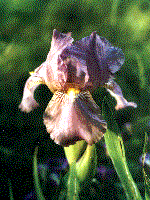 |
IRIDACEAE - The Iris Family
There are about 1800 species in this family, which occur in both tropical and temperate regions, but particularly around the Mediterranean, in South Africa and Central America. They are mostly grown as ornamental plants (Iris, Crocus, Gladiolus). |
Characteristics of this Plant Family:
Leaves, Stem & Roots ~ The members of this family are herbaceous and have storage organs (rhizomes, corms or bulbs). The leaves are long and thin, usually arranged in two rows and forming a fan shape.
Flowers ~ The flowers may be single and almost stemless (Crocus), or they may occur as spikes at the top of a branched or unbranched stem. There are six petals in two rings of three. Each ring or whorl may be composed of petals of the same or different shape and size. The typical Iris flower has three outer petals spreading horizontally, while the inner three petals stand upright. There are three stamens opposite the three outer petals.
Seeds ~ The seed pod in this Family forms behind the flowers, on the stalk side. It is composed of three chambers each with two rows of fairly large seeds.
(Click here for more information and examples of seedpods in this Family.)
Members of this Family usually have:
Bulbs or other storage organs
Long, thin leaves
Six petals in two rings
Three stamens
Seed capsule which forms behind the flower
Note: Members of this Family have several things in common with other bulbous plants in the Lily and Amaryllis Families. Here are some points of difference which might help tell them apart:
Liliaceae ~ 6 stamens, superior ovary (inside the flower)
Iridaceae ~ 3 stamens, inferior ovary (behind the flower)
Amaryllidaceae ~ 6 stamens, inferior ovary (behind the flower)